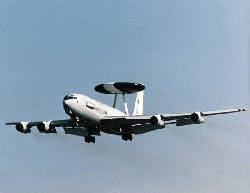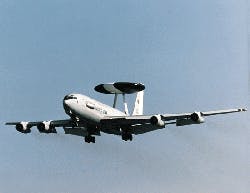CLADS program to replace CRTs with flat-panel displays in U.S. radar planes
CLADS program to replace CRTs with flat-panel displays in U.S. radar planes
By John McHale
ROBINS AFB, Ga. — U.S. government and industry experts are taking aim at crucial obsolescence issues as they relate to commercial off-the-shelf (COTS) avionics displays.
Engineers at Battelle Memorial Institute in Columbus, Ohio, and at the U.S. Air Logistics Command at Robins Air Force Base, Ga., have created a modular display architecture for replacing 19-inch cathode-ray-tube aircraft displays with flat panels, in a design approach that solves some COTS obsolescence problems.
Designers built the Common Large Area Display Set (CLADS) to be a low-cost, form/fit/function replacement for the E-3 Airborne Warning and Control System (AWACS) color monitor assembly, Airborne Battlefield Command and Control Center (ABCCC) airborne color display, the Joint Surveillance Target Attack Radar System (Joint STARS) graphics display unit, and the U.S. Navy E-2C Hawkeye Advanced Control Indicator Set (ACIS) display. The display is for an operator viewing at a console or workstation, or inside the rear cabin of an aircraft.
The common design will reduce the cost of operation and maintenance by an estimated $3.3 million per year on AWACS alone, claim Bob Zwitch, program manager for CLADS at Warner Robbins and Ronald Gorenflo, program manager for CLADS at Battelle.
It is realistic to anticipate savings of more than $30 million per year as designers implement CLADS widely across U.S. Department of Defense (DOD) applications. As commonality and open-systems interfaces begin to surface in DOD applications, the CLADS architecture can easily and cost effectively absorb the changes, and avoid COTS obsolescence issues, they say.
Originally CLADS was only for AWACS, but military leaders later expanded the program to other platforms to increase proram funding, Zwitch says. CLADS will cost about 25 percent of the original AWACS displays, he says.
The current AWACS console was designed by Hazeltine in the 1970s — a company that is now part of GEC Marconi, Zwitch says. The AWACS consoles had high repair bills because all their parts were obsolete and difficult to buy, he adds.
Zwitch says his engineers made lifetime buys of about 40 units, but each unit cost about $150,000 because the systems were no longer in production. CLADS should enable designers to buy displays at $40,000 apiece and less, he says. CLADS will eliminate practically all of the maintenance costs because of its modularity, Zwitch says
"The current E-3 AWACS OD-106 Situation Display is a unique portrait monitor in that it has a 3-bit interlaced digital interface and assumes a left-to-right, top- to- bottom scan format with respect to the portrait mounting position," Gorenflo says. Other displays, he says "use non-interlaced analog [red-green-blue] video interfaces that scan left to right and top to bottom with respect to a landscape mounting position, regardless of the actual mounting configuration."
The E-3 AWACS CLADS was the first of these initial applications to complete development, with the E-8 Joint STARS, the ABCCC, and the Navy E-2C Hawkeye CLADS following close behind.
The modular feature permits lifelong technology insertion upgrades without unnecessary redesign, and addresses many of the obsolescence problems associated with COTS technology-based acquisition, Gorenflo says.
Because the CLADS design is modular it is technology independent. For example, the Joint STARS "CLADS can be quickly assembled using any of three different display technologies currently packaged as a Common Large Area Display Head Assembly [CLADHA] while using the same bezel, video interface, power supply, and rear enclosure," Gorenflo says.
Zwitch says he hopes the CLADS design will become a standard for all the services. He and his team are working to make the CLADS specification flexible enough to meet the requirements of a wide range of air, ground, and sea-based ruggedized workstation display applications.
"Extended temperature, vibration, shock, moisture, and any number of other environmental considerations can be easily addressed beyond what has been currently specified for CLADS," Gorenflo says. "The supporting modules are designed with industrial-grade components capable of operation to -40 degrees Celsius. Two display technologies have been successfully operated at -20 C," he adds.
Battelle experts are also looking at giving CLADS sunlight readability.
The AWACS will receive 14 situation display consoles, which provide the operator with a display of radar/IFF video, graphics, and alphanumeric data on a 19-inch CRT-based situation display.
The E-8 Joint STARS, meanwhile, will receive 18 Operation and Control or Communications Workstation consoles provide a display of video, graphics, and alphanumeric data on a 19-inch CRT monitor.
The ABCCC is a palletized capsule that typically flies aboard C-130 aircraft. The ABCCC has 12 Airborne Color Displays, which provide a display of radar/IFF video, graphics, and alphanumeric data on a 19-inch CRT monitor.
The Navy E-2C aircraft have three ACIS consoles that provide a display of radar/IFF video, graphics, and alphanumeric data. These systems are undergoing new design and development activities that will use workstation designs based on commercial systems, open standards, and platform requirements.
Modular technology
The primary component of the CLADS system is a display head assembly module with an external power source, video interface, and optional slides or bezels completing the display unit. A CLADS application-specific power interface and video interface module will interface to a common 270-volt CLADS head assembly power supply and High Speed Digital Data Interface (HSDDI) inside the display system.
The CLADHA is the rugged large area, 25-pound high-resolution color display head, which can display color graphic, text, and video data at various frame rates with 1,280-by-1,024-pixel full-color groups. All data interfaces to the CLADHA are digital.
The application video interface module (AVIM) converts input video into HSDDI and centers the video as appropriate. The AVIM also provides the interface to the application system built-in test status and to the operator brightness and contrast controls, has test image generation capability, and stores all application configuration data and program code in non-volatile memory for retrieval by the Common Display Controller upon power-up.
The Common Display Controller (CDC) provides for control and testing of the CLADHA, AVIM, and Power Supply Module. The CDC configures the AVIM through the standard PC/104 bus using application data stored on the AVIM.
A Power Supply Module specification permits the use of a sub-modular front-end adapter for the various power needs. The AWACS displays and the ABCCC displays require three-phase, 115 VAC, 400 Hz power while the Joint STARS displays are powered from single-phase, 115 VAC, 400Hz power. The E-2C Hawkeye display requires 28 VDC.
The bezel and rear enclosure, are to a certain extent application specific. For example, the form, fit, and function requirements of the application for mounting purposes may define the bezel. In many CLADS applications, the bezel and rear enclosure of a previously designed CLADS will be reused
The CLADS head assembly can use COTS DMD, active-matrix liquid crystal display, AC gas plasma, and electroluminescent displays and field emissive displays if developed in larger sizes. The benefits have already become apparent.

